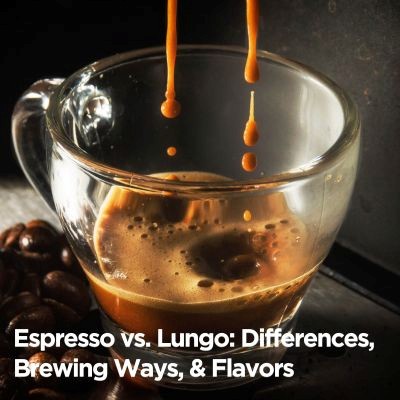Cold-brew coffee has experienced a remarkable rise in popularity in recent years, with a significant increase in demand globally.
According to recent market research, the cold-brew coffee market is projected to continue its robust growth, with an anticipated compound annual growth rate (CAGR) of over 22.7% between 2024 and 2031.
This growth features the increasing preference among consumers for this refreshing alternative to traditional hot coffee.
This comprehensive guide will explore cold brew coffee and everything you need to know about it, from its definition and unique characteristics to its brewing process, equipment options, health benefits, and more.
What is Cold Brew Coffee?
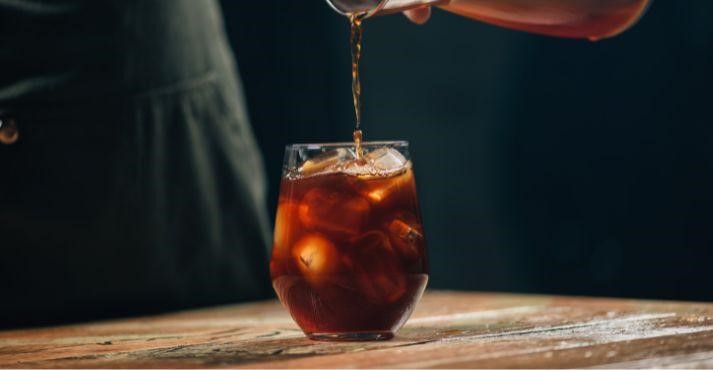
Cold-brew coffee involves steeping coarsely ground coffee beans in cold water for 12 to 24 hours. Unlike traditional hot brewing methods, this slow extraction process doesn’t use hot water, resulting in a smoother, less acidic coffee.
This unique flavor profile is why many people prefer cold brew, especially those who find regular coffee too harsh.
The cold brew ratio of water to coffee is typically 1:8, but you can adjust this to suit your taste. An excellent cold brew coffee maker helps achieve the perfect balance, ensuring the brew is strong enough.
But remember that cold brew coffee is not just a drink but a versatile base for various beverages. It can be enjoyed straight, over ice, or mixed with milk or cream for a refreshing twist.
How Cold Brew Coffee is Made
Making cold brew coffee is an art that combines patience with a bit of science to create a uniquely smooth and flavorful beverage. Here’s how to make cold brew coffee at home, step by step.
Basic Cold Brew Preparation Steps
1. Choosing Coarse Grind Coffee
The process of a perfect batch of cold brew starts with selecting high-quality coffee beans. For cold brew, it’s crucial to grind your beans to a coarse consistency, similar to raw sugar.
This coarse grind is essential because it allows optimal flavor extraction without over-extracting bitter compounds, which is especially important during the long steeping process of the cold brew. Explore various beans, like single-origin coffee, to find your preferred flavor.
2. Coffee Grounds and Water Ratio
The next step is to balance the coffee grounds to water just right. While this can vary based on personal taste, a good starting point is a cold brew ratio of one part coffee to four parts water.
This ratio ensures a potent, yet not overpowering, cold brew concentrate. You can adjust the ratio to suit your taste, but remember, the right cold-brew coffee maker can make this process easier and more consistent.
3. Steeping Time and Filtration
The heart of the cold brew process is the steeping. This is where patience pays off. Place your mixture of water and coarse grounds in the refrigerator or at room temperature for 12 to 24 hours. The longer you steep, the more robust and more developed the flavors. After steeping, filter out the coffee grounds using a fine mesh or a coffee filter. This filtration leaves you with a smooth, rich cold brew concentrate that can be enjoyed over ice or diluted with water or milk.
Cold Brew Equipment Options
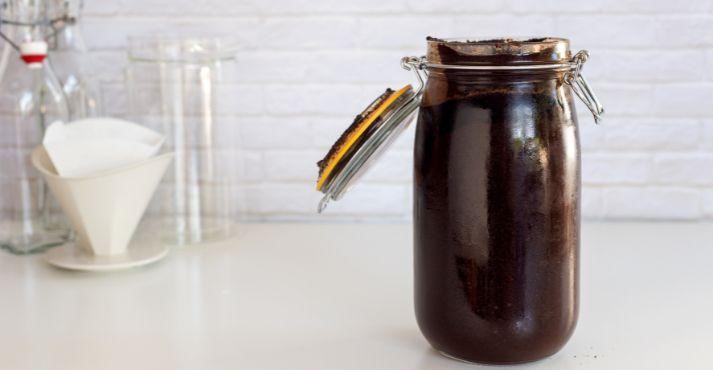
Creating the perfect cold-brew coffee isn’t just about choosing the right beans and ratios; it also involves selecting the best F&B equipment for your brewing needs. Several options are available, each designed to simplify the process and improve your brewing experience. Here’s a look at some popular cold brew equipment options:
French Press
A classic and versatile choice, the French press is great for hot coffee and excellent for making cold brews at home. It allows for easy steeping and filtration all in one vessel.
To use a French press for cold brew, add your coarsely ground coffee and cold water, stir, cover, and let it steep in the refrigerator. Press down the plunger after 12-24 hours, and your cold brew will be ready to serve. This method is perfect for those who appreciate simplicity and a hands-on approach.
Cold Brew Coffee Makers
Electric cold brew coffee makers are ideal for a more automated and consistent experience. These devices are designed to precisely control the steeping time and temperature, ensuring that every batch of cold brew is perfect.
Many models come with built-in filters and accessible dispensing features, making the process as simple as adding coffee and water and letting the machine do the rest. Explore various models to find one that fits your lifestyle and kitchen.
Immersion Cold Brewers
Immersion cold brewers are designed for ease and convenience, particularly for those who prefer a set-it-and-forget-it method. These brewers often consist of a large pitcher with a built-in filter or a separate infusion basket where you add coarse-grind coffee.
Once you add water, you can leave it to steep without worrying about over-extraction. After the steeping period, remove the filter or basket, and your cold brew is ready to drink or store.
Mason Jar and Strainer Method
This is a budget-friendly and straightforward option using a mason jar and a fine strainer. This DIY approach involves adding coffee grounds and water directly into the jar, stirring, and sealing it for the steeping period. Once ready, pour the mixture through a strainer lined with cheesecloth or a fine mesh to separate the grounds from the cold brew concentrate. This method is excellent for beginners and those who prefer to avoid investing in specialized equipment.
Commercial Cold Brew Systems
For coffee enthusiasts or professionals looking to make larger batches of cold brew, commercial cold brew systems offer a robust solution. These systems can handle large volumes and often feature durable filters and taps for easy dispensing. They are ideal for restaurants, cafes, or severe home brewers who need efficiency and volume.
Benefits of Cold Brew Coffee
Cold brew coffee isn’t just a trendy way to enjoy your daily caffeine fix; it also offers several health and taste benefits that make it a favorite among coffee lovers. Here’s a closer look at why cold brew might be the perfect choice for you:
1. Reduced Acidity: One of the most significant benefits of cold brew coffee is its lower acidity levels. Because the coffee grounds are never exposed to hot water, the brewing process doesn’t extract as many acidic compounds typically found in hot coffee. This results in a smoother and gentler brew on the stomach, making it an excellent option for individuals with acid sensitivity or those who suffer from heartburn.
2. Smoother Taste: Cold-brew coffee is known for its smooth, rich, and less bitter flavor profile. The extended steeping time allows the water to extract the coffee’s flavors gradually, avoiding the bitter oils and fatty acids that are often released in high-temperature brewing. This smoothness makes cold brew a pleasant alternative for those who might find regular coffee too harsh.
3. Higher Caffeine Concentration: While the caffeine content in cold brew can vary, it generally has a higher concentration than traditional hot coffee. This is due to the higher cold brew ratio of coffee to water used in preparation. However, because cold brew is often diluted before serving, you can control the caffeine level to suit your preference, making it both potent and adaptable.
4. Longer Shelf Life: Another practical benefit of cold brew is its longevity. Cold brew can be stored in the refrigerator for up to two weeks without significantly losing flavor quality. This makes it convenient for those who want to prepare their coffee in bulk and enjoy it over time. This shelf-stable nature means you can always have a delicious and refreshing cold brew concentrate ready to be enjoyed.
5. Versatility in Beverages: Cold brew coffee’s mild and smooth profile makes it an excellent base for a variety of coffee beverages. Cold brew is incredibly versatile whether you enjoy it straight, with ice, mixed with milk or cream, or even in coffee cocktails.
6. Health Benefits: Beyond its flavor, cold-brew coffee is associated with several health benefits. The lower acidity can lead to better dental health, as it’s less likely to erode tooth enamel. Additionally, cold brew contains compounds that may reduce inflammation and lower the risk of certain diseases. The smoother taste and reduced bitterness can also mean less sugar and cream are needed to make it enjoyable, which is a plus for those watching their caloric intake.
Cold Brew vs. Iced Coffee
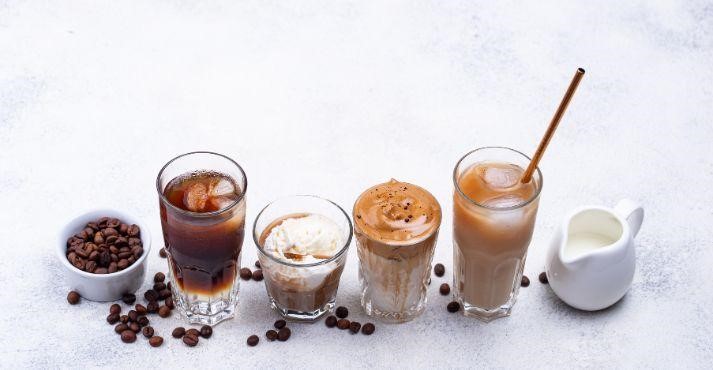
Understanding the differences between cold brew and iced coffee is essential, as they vary significantly in preparation, taste, and caffeine content.
- Brewing Method: Cold brew is created by steeping coarse-grinded coffee in cold water for 12 to 24 hours. This slow process extracts a smooth, rich flavor. In contrast, iced coffee is simply hot-brewed coffee that’s then cooled down and poured over ice. This quick brewing method can retain traditional hot coffee’s bitter and acidic flavors.
- Flavor Profile: Due to its brewing method, cold-brew coffee offers a smoother, sweeter, and less acidic taste, which makes it gentler on the stomach. Iced coffee, however, tends to be sharper and more bitter, similar to regular coffee but cooled. This difference is because iced coffee captures the high acidity and bold flavors of hot brewing.
- Caffeine Content: Cold-brew coffee often has a higher caffeine concentration than iced coffee because of the higher cold-brew ratio of coffee to water. While cold brew is typically diluted before serving, its base is a potent concentrate, whereas iced coffee starts with a regular-strength brew and may be further diluted by melting ice.
Cold Brew vs. Nitro Cold Brew
Another exciting variation of cold brew that’s gaining popularity is nitro cold brew. This innovative drink is infused with nitrogen gas, significantly changing its texture and flavor.
- Nitrogen Infusion: Nitro cold brew involves infusing cold brew coffee with nitrogen gas, which creates a creamy, silky texture and a beautiful cascading effect when poured. This process enhances the coffee’s natural flavors, giving it a sweet, smooth finish without adding sugar or cream.
- Velvety Mouthfeel: The infusion of nitrogen gas gives the nitro cold brew a velvety mouthfeel that sets it apart from other coffee drinks. It’s like drinking a fine beer, with its rich, bubbly nature that develops the overall experience.
- Reduced Acidity and Bitterness: The nitrogen improves the texture and mows out the acidity and bitterness often found in traditional brews. This makes nitro cold brew a fantastic choice for those who prefer a less acidic coffee.
Popular Types of Cold Brew Coffee
Cold brew coffee is refreshing and incredibly versatile, allowing for numerous creative variations and flavor combinations. Here are some popular ways to enjoy this smooth beverage:
1. Nitro Cold Brew
This coffee variation infuses cold brew with nitrogen gas, creating a creamy texture and velvety feel. The nitrogen infusion gives nitro coffee a rich, frothy top for more about this unique style.
2. Flavored Cold Brew
For those who love extra flavor, cold brews can be enhanced with natural flavors like vanilla, caramel, or chocolate. Adding these flavors can personalize your coffee experience, making each sip a perfect blend of smooth coffee and sweet, aromatic undertones.
3. Cold Brew Concentrate
A highly concentrated form of cold brew that serves as a versatile base for various coffee drinks. This cold brew concentrate can be diluted with water or milk or even used in recipes to customize the strength and flavor to your liking. It’s perfect for those who want to adjust their coffee’s intensity and experiment with different dilutions and mix-ins.
How to Enjoy Cold Brew Coffee
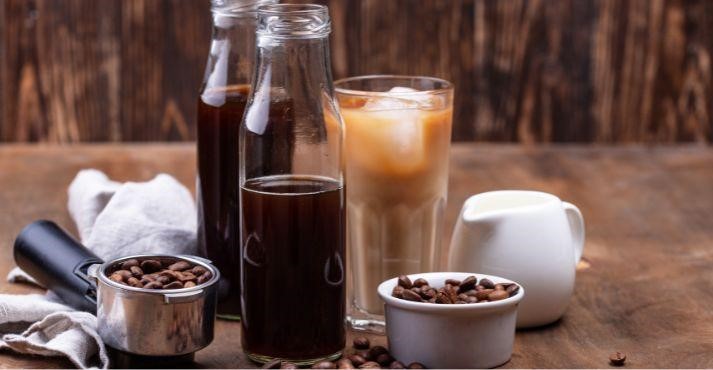
To fully appreciate the rich flavors and smooth texture of cold brew coffee, here are some simple and practical tips for serving and savoring this delightful beverage:
- Serving Temperature: Cold brew coffee is best enjoyed chilled to enhance its smooth and rich flavor profile. Serve it over ice or from the refrigerator to keep it refreshingly cold. Pouring the cold brew into a clear glass can showcase its clarity and deep color, making it a beverage and a visual treat.
- Serving Vessels: To further enhance the drinking experience, serve your cold brew in a glass or mason jar. These vessels are perfect for highlighting the coffee’s visual appeal and color. If you’re on the move, a travel tumbler is a great choice for enjoying your cold brew while maintaining its ideal temperature and flavor.
- Flavor Pairings: Cold-brew coffee’s natural sweetness and depth pair wonderfully with various Add a hint of chocolate, a sprinkle of cinnamon, or a citrus twist to complement the coffee’s inherent flavors. These additions can elevate your cold-brew experience, making each sip uniquely satisfying.
- Dilution and Strength: If you find the taste of cold brew concentrates too strong, dilute it with water, milk, or a dairy alternative to adjust the strength to your liking. This customization makes cold brew a versatile choice for various taste preferences and occasions.
- Creative Mix-Ins: For an extra special touch, consider adding syrups, spices, or even a bit of cream to create your perfect cup. Vanilla, caramel, and hazelnut are popular syrups that blend beautifully with cold brew. For a healthier twist, a dash of coconut or almond milk can add a creamy texture without overpowering the coffee’s natural flavors.
What is Cold Brew? (FAQs)
How long does cold brew last?
Cold brew can typically be stored in the refrigerator for up to two weeks, although its flavor may start to degrade after the first week.
How much caffeine is in cold brew coffee?
Due to its concentrated nature, cold brew coffee tends to have a higher caffeine content per serving than traditional hot coffee.
Is cold brew stronger?
Yes, cold brew coffee can be stronger than hot coffee in terms of caffeine content, but its flavor profile is often smoother and less acidic.
Is cold brew less acidic?
Cold brew is generally less acidic than hot coffee, making it a gentler option for individuals with sensitive stomachs or acid reflux.
Conclusion
In conclusion, the world of cold brew coffee beckons with its captivating allure and distinctive brewing process. The smooth and less acidic taste of cold brew has won the hearts of coffee lovers, offering a refreshing and delightful coffee experience like no other.
The unique cold brew process, involving patient steeping in cold water, brings forth a concentrated coffee base that delights the senses. Its versatility is another marvel, from classic iced versions to trendy coffee-based beverages like cold brew lattes and nitro cold brew, offering a range of choices to suit every preference.
Cold brew’s influence in the coffee world is undeniable. It has transcended the boundaries of specialty coffee shops and become a staple in mainstream coffee chains, representing a shift in coffee consumption trends and reflecting the coffee revolution underway.






